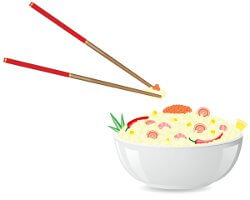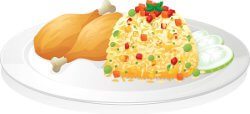English Reading Practice
Chinese Cooking
China is one of the largest countries in the world. Over the past hundred years, Chinese culture has spread throughout the globe.
Today, in nearly every city around the world, you can find Chinese language classes, Chinese stores, and Chinese restaurants.
What most people do not know is that in China, each region has a very different cuisine. "Cuisine" means a style of cooking. While there are some foods that you can find in all regions of China, some are very specific to certain areas because of the climate (weather) or the landscape.
Rice, noodles, soybeans, and vegetables can be found in food around China. They are staple foods. A "staple" is something that is basic, standard or always there.
Rice is a very important part of Chinese cuisine, especially in the southern part of China where the rice farms are. Noodles are also very important and can be found around China in soups or in dishes of their own. Sometimes they are served hot and sometimes they are served cold.

Vegetables are also found in food all over China. Many Chinese vegetables only grow in China and so people in other countries have never tasted them.

Within China, there are eleven major different kinds of cuisine. There are only three or four of these that are easily found outside China.
The most popular and easily found Chinese cuisine found in countries outside of China is called Cantonese cuisine.
This cuisine comes from an area in the southeastern part of China that is called Guangdong Provence.
This area is on the ocean and also has many rivers. The weather is usually wet and hot. This means that there are specific kinds of crops (plants people grow) that can grow in the area. However, being on the ocean and rivers means that food can come from other parts of China to the area. Both of these things influence the kinds of food that are found in Cantonese cuisine.
People who eat Cantonese food will be able to find beef, chicken, pork, and seafood (fish) dishes. They will also find plenty of dishes made with rice and noodles as well as lots of vegetables.

There are different kinds of cooking that are used in Cantonese cuisine, but one thing they all have in common is that they are quick (fast). Cantonese cuisine does not have very many dishes that take hours to cook. Usually, Cantonese food can be made in just a few minutes with fresh ingredients.
When you are eating Chinese food, it is important to remember that the food you are eating represents (shows) just one region in China. Chinese cuisine, just like China itself, is very diverse (different) and has many different kinds of dishes, flavors, and ingredients.
And now, practice:
Chinese Cooking - Exercises
Vocabulary Questions
1. What does "cuisine" mean?a) style of cooking
b) kind of language
c) kind of people
d) style of stories
b) kind of language
c) kind of people
d) style of stories
2. What does "staple" mean?
a) something that is hard
to find
b) something that is always available
c) something that is only available some of the time
d) something that is never available
b) something that is always available
c) something that is only available some of the time
d) something that is never available
3. What does "seafood" mean?
a) beef
b) chicken
c) pork
d) fish and sea creatures
b) chicken
c) pork
d) fish and sea creatures
Grammar Questions
1. Each region in China ________ a very different cuisine.a) has
b) had
c) has had
d) will have had
b) had
c) has had
d) will have had
2. The most popular Chinese cuisine found outside ________ China is called Cantonese cuisine.
a) in
b) at
c) on
d) of
b) at
c) on
d) of
3. Both of these things influence ________ kinds of food that are found in Cantonese cuisine.
a) a
b) the
c) an
d) that
b) the
c) an
d) that
Comprehension Questions
1. What are some "staple" foods found in Chinese cuisine?_______________________________________________________________
2. How many different kinds of Chinese cuisine are there?
_______________________________________________________________
3. What kind of cuisine is most commonly found outside of China?
_______________________________________________________________
Get Updates, Special Offers, and English Resources
Download your FREE GIFT (the first two chapters of
English Short Stories Book and Workbook)
as soon as you join!

By submitting your email, you consent to receiving updates and newsletters from us and to the sharing of your personal data with third parties for the purposes of sending you communications. We will not spam you. You can unsubscribe at any time. For more information, please see our privacy policy.




